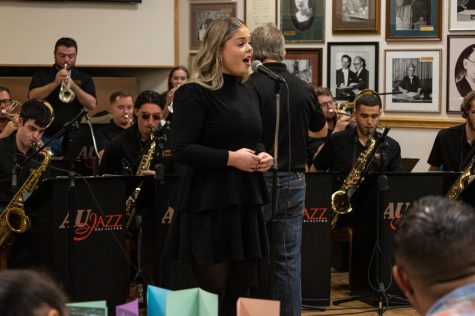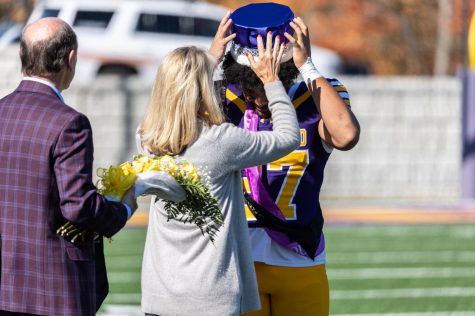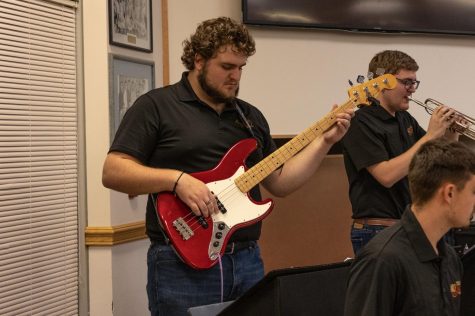‘On the Edge’ hoped to invoke intensity and reflection
April 7, 2011
The play “On the Edge” by senior Courtney Long had a small audience Sunday in the Hawkins-Conard Student Center. As the audience settled in and the clock ticked passed 1:30 p.m., the air seemed light and happy. Some of the actors were passing out programs and were talking with audience members and the rest of the actors settled themselves in seats amongst the spectators. Long signaled to her performers to close the auditorium doors and made the announcement that the play was beginning and that it would be intense.
As the performers recited their beginning lines and made their way to the stage, it was clear that Long cast her parts very well. Freshman Malyn Collins played Sam, a fifteen-year-old suffering from severe clinical depression. Junior Christina Neely played her doctor, Dr. Zoe Loft. Collins’s character was loud and quirky, and wasn’t the stereotypical depressed teenager you would expect to see portrayed. She was sarcastic, funny and almost vivacious at times. It was a good example of how people with depression don’t always have to walk around dull and sad-looking.
However, I was a little disappointed with the relationship portrayed between doctor and patient. While many people do have bad experiences with doctors or therapists, I was hoping that this play would encourage people with depression to keep trying to seek help until they find a professional that is excellent in their field. However, Dr. Loft simply seemed to be oblivious, continually saying she would see Sam the next day even after Sam stated that she would rate herself as a 3, meaning that she thinks about killing herself often – a clear warning sign that something other than weekly visits needs to be done; a warning sign I would hope most doctors recognize and take action against.
In a play where only one real doctor-to-patient interaction was shown, I wanted to see at least a hint of help from the doctor, in hopes that it would encourage others to seek help. It is fair to note that on the back of the program it was stated, “If you or anyone you know is suffering from depression or suicidal thoughts, please seek help immediately from a professional.” But the professional in the play didn’t seem to be helping Sam, which made doctors look like a discouraging option.
Freshmen Elizabeth Ross and Will Saxon played a couple, Brooke and Eli. While Eli seemed to understand or slightly suffer from depression, Brooke was the focus. Using a relationship as a means to portray how people cope with depression was an interesting choice. Instead of seeking professional help, Brooke turned to Eli to help her through her problems. It was nice to see the dynamic of what a friendship can do for a person’s mental health and depression issues. Their relationship was rocky and hard at times, which I was happy about. No girl should think that having a boyfriend can save her from depression and it was nice to see that she still had problems at times; they both had to work through depression and deal with it. I hope that those who watched the show also kept in mind that a friend is what is needed most, not necessarily a love interest.
Senior Brad Eustathios played what I think was the most prominent role as Caleb, a young man refusing to reach out to anyone else and fighting with himself and his thoughts. Sophomore Megan Lilly backed him up by playing Caleb’s thoughts. Long not only did an excellent job at selecting these two actors to portray the parts, but she also gave them the best interactions. Their dialogue and scenes were the most powerful and allowed the audience to truly appreciate the art and meaning behind the play and the message Long wanted to deliver. This duo was also centered in the middle of the stage, with the other two sets of characters on either side. This only solidified my impression that Caleb and his thoughts were the most important characters in the play, as well as the most accurate and unbiased.
The most powerful scene in the play was, of course, when the three teenagers were getting ready to throw themselves off the bridge. The actual action was the most impressive and statistically correct. While Sam and Brooke both ended up living, Caleb jumped off and died. The visual of watching the two girls fall backwards to safety, with the boy falling forwards to his death was expertly set up, especially in such a small auditorium.
At the end, Long explained that in the hour and a half that it took to perform the show, 72 teenagers had tried to commit suicide and five of them had succeeded. It was an effective ending and the audience left disheartened.









